Oklahoma Scope of Practice
Life in the Sooner State

Where the wind does in fact come sweeping down the plains, Oklahoma is a state full of pride and progression. From a night on the town spent in Bricktown in Oklahoma City to visiting the Hard Rock Café in Tulsa, there is a booming nightlife in Oklahoma’s cities. These cities are advancing hubs of activity with an array of districts offering popular and upcoming local restaurants, breweries, and casinos. They also have as a breathtaking array of museums and architecture. Divided by 100 miles of historical Route 66, along the way there are many charming small towns. These towns all offer their own unique take on what it means to be an “Okie.”
Things to do
If you’re into sports, Oklahoma is home to several sports teams. Basketball fans will cheer for the the Oklahoma City Thunder. Baseball fans can enjoy the Los Angeles Dodgers minor league affiliate Oklahoma City Dodgers. Country music fans know Oklahoma as the home state of stars Blake Shelton, Toby Keith, and Garth Brooks. If the natural scene is more of an appeal, there are many options. Spend a weekend on a boat out on Eufaula Lake. You can also take a day floating down one of the numerous rivers in eastern part of the state. Above all else, be sure to take a minute to pause and marvel over the breathtaking scene that is an Oklahoma sunset.
People and culture
A focal point of Native American people and culture, nearly 40 tribes and tribal organizations still reside within the state. This makes Oklahoma the third largest Native American populated state in the U.S., behind Alaska and California. The historical influence of Native American heritage is profound within the city names and traditions.
Practicing Optometry in Oklahoma
Given the amount of population that is comprised of Native Americans, a big contributor to the health care needs (including optometry) of the community is served by the Indian Health Services. The IHS a Federal Health Program for American Indians and Alaskan Natives. IHS serves regions all across the country, with the branch in OKC extending out to Oklahoma, Kansas, and parts of Texas. There are 18 healthcare facilities in Oklahoma alone.
Additionally, Oklahoma is home to one of the 23 optometry schools in the US. Northeastern State University College of Optometry in Tahlequah, OK. NSUCO oversees a number of residency programs in Oklahoma and a select few in the surrounding states. These programs offer a wide variety of opportunities with such disciplines as Primary Care, Ocular Disease, Vision Rehabilitation, Contact Lenses, Refractive/Ocular Surgery, and an Optometric Management Education Program.
Scope of Practice in Oklahoma
Oklahoma is a national leader in eye care. With its nationally renowned college of optometry, uniquely medically-minded broad scope of practice, and its strict state regulations that restrict optometrists to practicing in medical settings only, Oklahoma optometrists have a great level of respect. Optometrists in Oklahoma are able to practice on a stage that allows them to provide the best eye care possible.
In November of 2018, Oklahoma voted against State Question 793, which was a proposal to allow optometrists to practice within a retail establishment that sells merchandise to the public, such as a large supercenter. The original proposition can be seen here. Although supporters say that this law could support cheaper office visits and eyewear, this question was ultimately rejected by the public. The fear was that the quality of eyecare would diminish. With that, eyecare in Oklahoma would become more profit and retail driven rather than patient care driven. This proposal may have been unsuccessful on this last ballot, but it remains an issue that state lawmakers could always revisit in the future. Remain mindful and educated, Oklahomans.
In Oklahoma, optometrists CAN:
- Administer medications, including anesthetics, by injection, including subcutaneous infiltrative, intralesional, intramuscular, intravenous, and subconjunctival routes
- Perform anterior segment laser procedures including YAG capsulotomy used to treat cloudy lens implants following cataract surgery, Selective Laser Trabeculoplasty (SLT) and Laser Peripheral Iridotomy (LPI) used to treat some forms of glaucoma
- Perform minor surgical procedures to correct ocular abnormalities, such as removal of “lumps and bumps” around the eye
- Prescribe oral medications, including Schedules II (hydrocodone-combination products), III, IV, and V drugs
- Prescribe oral steroids
- Diagnose and treat glaucoma with topical and oral drugs
- Co-manage post-op care
- Perform procedures such as foreign body removal, dilation and irrigation, punctal occlusion, and eyelash epilation
In Oklahoma, optometrists CANNOT:
- Perform cataract extractions, retinal surgery, or refractive surgery (such as LASIK)
- Laser or non-laser injection into the posterior chamber of the eye to treat any macular or retinal disease
- Administer general anesthesia
The Oklahoma Association of Optometric Physicians (OAOP) Vision Summit will be held in Norman, Oklahoma, on April 4-6, 2019. This will be an event full of a three day educational conference and a two day exhibit hall. This conference will be offering many opportunities for continuing education and networking.
For more articles and information about the optometric scope of practice in other states, click here.



